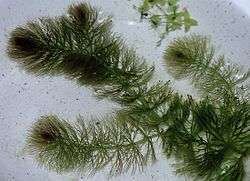Ceratophyllum
| Ceratophyllum | |
|---|---|
 | |
| Ceratophyllum submersum | |
| Scientific classification | |
| Kingdom: | Plantae |
| Clade: | Angiosperms |
| Order: | Ceratophyllales Link[1] |
| Family: | Ceratophyllaceae Gray[1] |
| Genus: | Ceratophyllum L. |
| Synonyms[2] | |
| |
Ceratophyllum is a cosmopolitan genus of flowering plants including four accepted species in 2016,[3] commonly found in ponds, marshes, and quiet streams in tropical and in temperate regions. It is the only genus in the family Ceratophyllaceae,[2] itself the only genus in the order Ceratophyllales.[4] They are usually called coontails or hornworts, although hornwort is also used for unrelated plants of the division Anthocerotophyta.
Ceratophyllum grows completely submerged, usually, though not always, floating on the surface, and does not tolerate drought. The plant stems can reach 1–3 m in length. At intervals along nodes of the stem they produce rings of bright green leaves, which are narrow and often much-branched. The forked leaves are brittle and stiff to the touch in some species, softer in others. The plants have no roots at all, but sometimes they develop modified leaves with a rootlike appearance, which anchor the plant to the bottom. The flowers are small and inconspicuous, with the male and female flowers on the same plant. In ponds it forms thick buds (turions) in the autumn that sink to the bottom which give the impression that it has been killed by the frost but come spring these will grow back into the long stems slowly filling up the pond.[5][6][7][8]
Hornwort plants float in great numbers just under the surface. They offer excellent protection to fish-spawn, but also to snails that are infected with Bilharzia. Because of their appearance and their high oxygen production, they are often used in freshwater aquaria.
Taxonomy
Ceratophyllum is considered distinctive enough to warrant its own family, Ceratophyllaceae. It was considered a relative of Nymphaeaceae and included in Nymphaeales in the Cronquist system, but recent research has shown that it is not closely related to Nymphaeaceae or any other extant plant family. Some early molecular phylogenies suggested it was the sister group to all other angiosperms, but more recent research suggests that it is the sister group to the eudicots. The APG III system placed the family in its own order, the Ceratophyllales.[1][2][9] The APG IV system accepts the phylogeny shown below:[4]
| angiosperms |
| |||||||||||||||||||||||||||||||||||||||
| |
Species
The division of the genus into species is not completely settled. More than 30 species have been described, but many are probably just variants of these more widely accepted species:[2][5][6][10][11][12]
- Ceratophyllum demersum L. (rigid hornwort or common hornwort) - cosmopolitan
- Ceratophyllum muricatum Cham. (prickly hornwort) - widespread in many places though not all countries
- Ceratophyllum platyacanthum Cham. - Scattered locations in Germany, Hungary, France, Russia, China, Japan, Korea
- Ceratophyllum submersum L. (soft hornwort or tropical hornwort) - Europe, Central Asia, northern Africa, scattered places in tropical Africa, Turkey, Oman, Florida, Dominican Republic
Of these, Ceratophyllum demersum is widespread, with a global distribution; the others all have more restricted ranges.
References
- 1 2 3 Angiosperm Phylogeny Group (2009). "An update of the Angiosperm Phylogeny Group classification for the orders and families of flowering plants: APG III" (PDF). Botanical Journal of the Linnean Society. 161 (2): 105–121. doi:10.1111/j.1095-8339.2009.00996.x. Retrieved 2013-06-26.
- 1 2 3 4 Kew World Checklist of Selected Plant Families
- ↑ Christenhusz, M. J. M.; Byng, J. W. (2016). "The number of known plants species in the world and its annual increase". Phytotaxa. Magnolia Press. 261 (3): 201–217. doi:10.11646/phytotaxa.261.3.1.
- 1 2 Angiosperm Phylogeny Group (2016). "An update of the Angiosperm Phylogeny Group classification for the orders and families of flowering plants: APG IV". Botanical Journal of the Linnean Society. 181 (1): 1–20. doi:10.1111/boj.12385.
- 1 2 Flora of China: Ceratophyllum
- 1 2 Flora of North America: Ceratophyllum
- ↑ Blamey, M. & Grey-Wilson, C. (1989). Flora of Britain and Northern Europe. ISBN 0-340-40170-2
- ↑ Huxley, A., ed. (1992). New RHS Dictionary of Gardening. Macmillan ISBN 0-333-47494-5.
- ↑ Angiosperm Phylogeny Web: Ceratophyllales
- ↑ Germplasm Resources Information Network: Ceratophyllum
- ↑ Australian Plant Name Index: Ceratophyllum
- ↑ Flora Europaea: Ceratophyllum
External links
| Wikimedia Commons has media related to Ceratophyllum. |